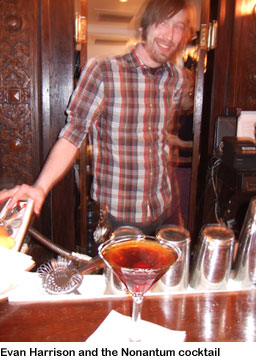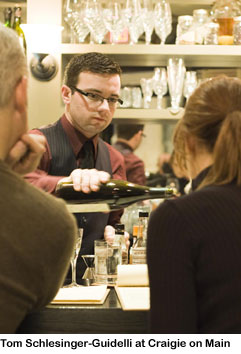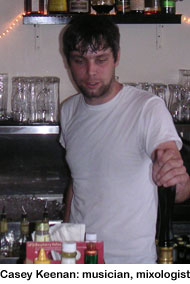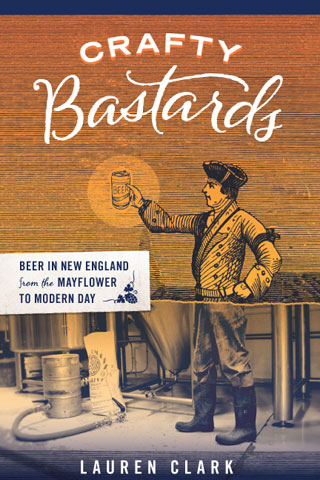January 31st, 2009

Something about the Boston bar scene really hit home for me recently: there’s a bunch of cute, young guys in this town creating spectacular drinks. Evan Harrison’s Nonantum, Tom Schlesinger-Guidelli’s Northern Lights and Casey Keenan’s Bohannon, to name a few. I’m besotted.
Take Harrison of the Independent — only a year or two out of college, and already he’s figured out how to use the herbal, day-glo-yellow Italian liqueur Strega (a.k.a. “witch”) in a cocktail. Check this out:
Nonantum
2 parts Old Overholt rye
1 part Punt e Mes
1 part Strega
1 dash each Angostura bitters and Regan’s orange bitters
Stir over ice until very cold and strain into a chilled cocktail glass.
“It’s a pretty clear take off of the Green Point cocktail, just substituting Strega and bitters for the Yellow Chartreuse,” Harrison says.
“I came up with this in an attempt to find something to do with Strega apart from dust the bottle and answer questions about it. Strega is a cool little spirit with a cool history, but it’s too sweet to shoot or even sip on its own, and I’ve never seen it called for in any recipe. Surprisingly, it draws out the bitter orange flavors in the Punt e Mes while letting the rye do its work. And also to Strega’s credit, it gives the drink a cool, thick viscosity that kind of lingers in your mouth.”
Yeah, that pretty much sums it up. The upshot is that this drink is worthy of distinction among its many rye-liqueur-vermouth brethren, including Drink’s Fort Point.
OK, but the Nonantum? “The name comes from that village in Newton, where I was once stranded after a bizarre Catholic festival. I mistook the name for being Latin and thought it had something to do with their odd form of civic organization. I was wrong, but I still like the name.” As Harrison later learned, Nonantum is in fact a Native American word meaning, appropriately, “rejoicing.”

Schlesinger-Guidelli has barely cracked the quarter-century mark, but he already has some stellar cocktails to his name, notably the Jaguar and the new Northern Lights. The NL is one of those drinks where each layer of flavor shines on its own but contributes to a greater whole, like dance sequences in a great MGM musical.
The story behind the drink? “I took a week off between starting at Craigie and ending at Eastern Standard. I went down to Westport, MA, to work on the upcoming venture. One night of mixing with some of my best friends, this drink just came together. The late-night mixing and watching the stars, in cold New England … it reminded me of the vibrant Northern Lights.”
Northern Lights
1 ½ oz William Grant & Sons Scotch
¾ oz. St. Germain Elderflower Liqueur
½ oz. Fresh lemon juice
¼ oz. Clear Creek Douglas Fir Eau De Vie
¼ oz. Fresh orange juice
¼ oz. Demerara syrup (1:1 demerara sugar and water)
2 dashes Bittermens ‘Elemakule Tiki Bitters
Shake very well over ice, strain into a cocktail glass, and garnish with a lemon twist. Notes: Find demerara sugar (or sugar in the raw) at specialty stores like Christina’s in Inman Square. Also, S-G is pretty insistent on the brand of scotch: “I think the honeyed nature of Grant & Sons is really beautiful here.”

I admit I have yet to try Casey Keenan’s Bohannon, but it came to my attention via a trusted source. When he’s not playing drums for the Major Stars, Pants Yell! and other outfits, Keenan can be found at Deep Ellum. Recently, he took the Swedish Punsch that Ellum bar czar Max Toste made and created a cocktail with it that enamored Imbibe magazine enough to appear in the January/February issue. If you know Keenan and his love for 1960s and ’70s music, you’ll be amused but not surprised by the fact that he named the drink after disco producer Hamilton Bohannon.
Bohannon
2 oz gin
½ oz Green Chartreuse
½ oz Swedish Punsch
Pinch of fresh black pepper
Shake very well over cracked ice and strain into a chilled cocktail glass. Garnish with black pepper.
Tags: Boston cocktails, Casey Keenan, Evan Harrison, Tom Schlesinger-Guidelli
Posted in Bartenders, Cocktails, Liqueur, Whiskey | 8 Comments »
January 12th, 2009
 An interview with Misty Kalkofen
An interview with Misty Kalkofen
By MC Slim JB
Boston bartender Misty Kalkofen recently became one of the few bartenders in the country to be certified by the Beverage Alcohol Resource (BAR). If you’re not in the hospitality industry, you can be forgiven for not knowing what a huge deal that is. Think of it as being named a Rhodes Scholar or a MacArthur Fellow for your work with a shaker and your deep understanding of spirits, cocktail culture and history. It takes a lot of training, serious study and the ability to pass a gut-wrenching examination with both lab work and written exercises.
The credential is relatively new. While wine professionals have been able to pursue Master Sommelier diplomas for decades, and chefs their culinary-school degrees for centuries, bartenders have had little to prove their skills other than their following. That changed in 2006, when a group of the industry’s brightest luminaries founded the BAR in New York City to train and certify cocktail professionals. Its faculty features some of the heaviest hitters in the business, including F. Paul Pacult, editor of Spirit Journal; Dale DeGroff, famed mixologist and founder of the Museum of the American Cocktail; Steven Olson, noted wine and spirits writer and educator; Doug Frost, a rare Master Sommelier and Master of Wine; David Wondrich, famed cocktail historian and correspondent for Esquire, and Andy Seymour of aka wine geek.
Ms. Kalkofen took the BAR’s five-day Intermediate course (tuition: $3,500), and by passing the grueling exam received the greater of the two levels of certification, BAR-Ready, which recognizes professional-level bartending skills in high-intensity environments, plus broad knowledge of the culture, history and makeup of spirits and cocktails. (The lesser credential, BAR-Certified, requires more modest bartending skills.) Her resume already reads like a greatest hits of serious Boston bars: she’s currently at Drink, Boston’s newest temple to Golden Age cocktails (her Drink colleague Josey Packard is the only other Boston bartender to be BAR-certified); she previously managed the bar at Green Street, another of Boston’s three or four best; and she’d worked a long stint at the bygone B-Side Lounge, the birthplace of Boston’s cocktail revival. I sat down with her to ask her about her work and her experience with the BAR exam.
MC Slim JB: Was the B-Side your first stint behind the bar?
Misty Kalkofen: Nope. My first bar gig was at the Lizard Lounge. That is also where I met Brother Cleve, who was instrumental in starting me down the road of cocktail lover/historian/geek! He did a weekly DJ night called Saturnalia, and each week he would teach me a classic cocktail recipe. After two years of Thursday nights, I had this nice catalog of delicious classic recipes in my noggin, and I was hooked!
MC: So what was your motivation for taking the BAR exam? Professional pride? Bragging rights with your peers? Career opportunities?
MK: I’d heard a lot about the BAR and had been interested in it for a while. Obviously, all one needs to do is read the bios of the instructors to realize that you will learn soooo much. And in any profession, if you stop learning, you stop growing, and the rest of the industry will pass you by. So the educational side was a huge draw for me. Also, I knew I would meet folks from all over the country who are interested in the same things I am. I love having people to talk to about ideas and trends, so the more bartenders and brand ambassadors I can meet the better!
MC: Tell me about the exam. I’ve heard it’s more stressful than the SATs and GREs combined. What are the different components?
MK: The exam consists of three parts. In the practical phase, they set up a faux bar situation in the kitchen of the Astor Center and took us in six at a time to make drinks. We were evaluated by two people: one instructor and one BAR graduate. They approached us as guests and started ordering drinks. We had to make six drinks, and were evaluated on technique, knowledge and our ability to make the drinks correctly and deliciously in the allotted time.
Part two was the tasting phase. First, we had to blind-taste two variations of the same cocktail and compare them. The point wasn’t to name the drink, but to contrast the two, saying which was more balanced and why. Next, we had to blind-taste six spirits. For each we filled out an evaluation sheet on which we had to list all the aspects of the spirit’s taste, both generally and specifically.
For example, I would mark the box for “tropical fruits,” but I would then need to write down which specific tropical fruits, e.g., coconut or banana. We assessed for fruit, non-fruit (flowers, herbs, spices, vegetables), wood and aging — for example, what notes (such as butterscotch or pepper) hint at barrel aging, what type of wood the spirit was aged in and for how long. We were also asked to estimate proof and to evaluate cleanliness, balance, oak integration, length of finish, complexity and quality. Finally, we had to identify what the spirit was made from, where, and what category it falls into. You could get extra credit for naming brands, a specific region of origin, etc.
Part three was a written exam: about a hundred true/false, multiple choice, short answer and essay questions. Then I had to critique a cocktail menu.
MC: Yikes! So, what drinks did you have to make?
MK: Four were from a list of the most important/common drinks from the manual that we’d been studying. For number five, I had to buy a spirit from Astor Wine and Spirits, make an infusion from it, and then create a cocktail based on the infusion. It could be something I’d worked with before or something new — it was up to me. The final cocktail was my choice. I made my evaluators (Don Lee of New York’s high-craft speakeasy PDT and Willy Shine of the BAR) a Hearst for my chosen cocktail. Interestingly enough, on the night before the exam, at a dinner in Chinatown, I predicted that Don Lee would be one of my evaluators and that I would make him a Hearst. Perhaps I missed my true calling: fortune teller!
MC: How cool! I’m dying to get to PDT. Do you remember the spirits in the blind tasting?
MK: Well, an answer to that would be pure speculation, as we never get a corrected copy of our exam back. The interesting thing about the blind tasting is that you could evaluate a spirit correctly as far as taste descriptors and aging evaluations were concerned and receive many points, while still arriving at the wrong conclusion as far as a spirit family was concerned.
MC: Sounds like my college topology course. What was the scariest part of the exam?
MK: Hmmm … well, making drinks in the practical phase was nerve-wracking because the setup was unfamiliar, and I was making drinks for two people that I have the utmost respect for in this field. But I was most nervous about the blind tasting. Even in an unfamiliar situation I feel confident in my mixing skills, but the finer points of tasting were new to me. Many of the other folks in the course had amazing palates and also had more background in the proper way to taste spirits, so the group tastings could be a bit intimidating and overwhelming.
MC: You’re a well-educated person: you’ve taken your share of other standardized tests. Were you one of those kids that slayed the SATs? Do you remember your scores?
MK: I don’t. I know my parents were psyched by them, but I have no recollection of what they actually were …
MC: Baloney! You’re just being modest, Ms. Smarty-Pants! So, did you come out of the BAR exam thinking, “Pish, I nailed it,” or were you on tenterhooks waiting for the envelope to deliver your fate?
MK: I didn’t breathe for weeks. I was so frickin’ nervous. Even after I found out I passed I didn’t believe it.
MC: How did you celebrate?
MK: I drank a couple big bowls of punch with the ladies of LUPEC [Ladies United for the Preservation of Endangered Cocktails] and our great supporters at Grand at the first LUPEC punch party!
MC: I’ve seen the photos; that one looked like a lulu! Is there a diploma on your wall now, or do they just teach you a secret handshake? Do you get to put extra letters after your name on your business card?
MK: I wish there was a secret handshake — I think I’ll bring that up. As far as the extra letters, I don’t think there is anymore room after the four already there: l.u.s.h.
MC: So does membership have its privilege, like better shifts? Can you ignore [Drink bar manager] John Gertsen’s advice now? Must your colleagues now refer to you as Madame Bartender or Queen of the Stick?
MK: Queen of the Stick — I like that one! Honestly, it just pushes me to stay on top of my game. Colleagues and coworkers come to me with questions because I’ve taken the course and I want to represent well. So I spend a lot of time with my head in the books reviewing materials and learning more!
MC: Any advice for would-be BAR exam takers?
MK: Start testing yourself on spirits. It doesn’t necessarily need to be blind, but taste ingredients outside of cocktails. Unfortunately that’s not something most bartenders frequently do unless they deal with purchasing. And read everything you can get your hands on.
MC: As a longtime fan of your bartending and hospitality skills, let me say thanks for taking the time to talk with me, and congratulations on your remarkable achievement!
MK: My pleasure!
Guest blogger MC Slim JB is a Boston-based writer whose restaurant reviews and food/drink features have appeared in Boston Magazine, the Boston Phoenix, stuff@night, and the Weekly Dig. MC is also a frequent contributor to the restaurant review website Chowhound.
Tags: MC Slim JB, Misty Kalkofen, mixology course
Posted in Bartenders | 9 Comments »
November 13th, 2008

A reader named Daniel emailed me recently asking what I knew of recent “bartender movement” around Boston, including what has become of the crew at the B-Side. Timely question, Daniel, because Boston drink-slingers are engaged in a lively round of musical bars right now.
Let’s start with the crew at the B-Side, which, it turns out, will not be opening again under new ownership as I wrote earlier. The lounge on the corner of Hampshire and Windsor in Cambridge is officially in limbo. Sad. From what I’ve heard, among the principal bartenders left standing when the place closed, Dave Cagle is heading to Deep Ellum, Al Harding is at the new-and-improved Cafe Marliave (along with ex-B-Siders Jackie Ross and Christopher Duggan, who’s also occasionally at the Indo), Russ is at the Beehive, and Rob … I totally forget where Rob’s going (update forthcoming). While I’m on the subject, the B-Side’s swan song, last Sunday, was an evening of fun insanity, with customers doing their damnedest to drain the place of every last ounce of liquor, and most of the above B-Side alums — plus Joe McGuirk and Claudia Mastrobuono, both now at Highland Kitchen — stepping behind the bar to help out.
As for the other bars with personnel in flux … Misty Kalkofen is moving from Green Street to Drink. That means Drink will now boast a ridiculous roster of talent including Kalkofen, John Gertsen, Ben Sandrof and Josey Packard, among others. Meanwhile, as Daniel informed me, Green Street has lured Emily of Deep Ellum across the river. She joins Andy McNees (formerly of Bukowski and Eastern Standard) and Bice (formerly of B-Side, Deep Ellum, etc.). Tom Schlesinger-Guidelli, who earned renown at Eastern Standard, is now boss of the bar at chef Tony Maws’ new place, Craigie on Main, which is scheduled to open this Friday.
I know I’m missing a few other significant moves, here. I’ll post updates when I get them, along with reviews of Boston’s new star bars Drink, Cafe Marliave and Craigie on Main. In the meantime, best of luck to all you ‘tenders in your new gigs.
Tags: bartender movement, new Boston bars
Posted in Bartenders, Boston bars | 14 Comments »
September 12th, 2008
 If you walk into Eastern Standard next week and wonder who that new kid is behind the bar, count your blessings. His name is Daniel Eun, and he works at PDT (Please Don’t Tell), a speakeasy-style cocktail bar in lower Manhattan. And if you’re wondering where Eastern Standard’s sweet-faced Kevin Martin is, don’t worry. He’s shaking up a few ES cocktails down at PDT. Yep, it’s a bartender exchange.
If you walk into Eastern Standard next week and wonder who that new kid is behind the bar, count your blessings. His name is Daniel Eun, and he works at PDT (Please Don’t Tell), a speakeasy-style cocktail bar in lower Manhattan. And if you’re wondering where Eastern Standard’s sweet-faced Kevin Martin is, don’t worry. He’s shaking up a few ES cocktails down at PDT. Yep, it’s a bartender exchange.
Jackson Cannon, bar manager at ES, and Jim Meehan, owner of PDT, are sending these two talented, young emissaries to each other’s bars for three nights: Monday, Tuesday and Wednesday. At PDT, Kevin will greet a clientele of in-the-know cocktail enthusiasts who enter the bar by ringing a bell on the wall of a phone booth inside a hotdog joint. At Eastern Standard, Daniel will tend to a sprawling mix of cocktail enthusiasts, businesspeople, baseball fans and tourists who enter the place through a clearly marked entrance in bustling Kenmore Square. Both bartenders will bring with them an abridged menu of drinks from their own bars. I, for one, am looking forward to meeting Daniel and ordering one of his cocktails. “He’s pretty feisty, they say. Young and gung-ho,” says Cannon.
Despite the two establishments’ differences, Cannon says that “bars are supposed to be like kitchens — there’s a common language. We’re putting that hypothesis to the test.”
The mastermind behind the bartender exchange is another NYC mixologist, Philip Ward of Death & Co. He helps coordinate the exchanges along with Rob Cooper, distiller of St. Germain Elderflower Liqueur, who as a goodwill gesture provides a small stipend to the bartenders for travel and lodging expenses. These two guys got wind of a “shot war” between Boston and New York bartenders who attended Tales of the Cocktail this year (the only war in which shots of Grey Goose are considered an attack), and figured they might as well nurture that rivalry. Good luck, Kevin and Daniel.
Tags: bartender exchange, daniel eun, eastern standard, kevin martin, pdt
Posted in Bartenders | 4 Comments »






